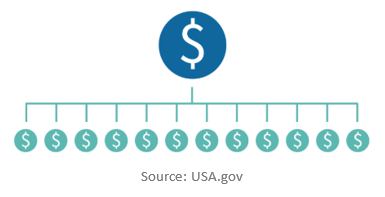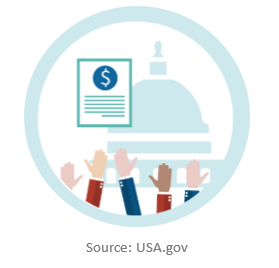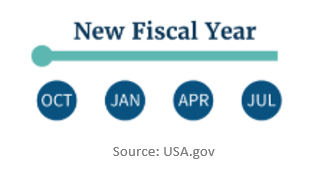I generally thought I understood what a continuing resolution meant, but I figured I’d dig a little deeper (but if I were like many of you in the government, it may be challenging to get funding to buy a shovel to actually do any digging). The problem we often face is having the time to understand the complexity of the government budget process, so here are five things you need to know to help you as a government client or as a government contractor to save you some time. So, here we are at the start of the government’s next fiscal year with the current spending authority having lapsed on Monday, September 30. This budget status seems (is) more the norm than the exception and always generates discussion related to whether the government will pass a “continuing resolution” or will it implement a government shutdown.
1. Where does it start?
. . .The House and Senate Committees on Appropriations have jurisdiction over the annual appropriations measures.
Each Committee is organized into subcommittees, with each subcommittee having responsibility for developing the annual appropriations bill to provide funding for departments and activities within its jurisdiction.
Each House appropriations subcommittee is paired with a Senate appropriations subcommittee and the two subcommittees’ jurisdictions are generally identical.
The current appropriations structure includes the following 12 subcommittees. Yes, 12 subcommittees but that makes sense because each oversees different agency funding. Can you imagine if they tried to resolve all of those under one subcommittee?
1. Agriculture, Rural Development, Food and Drug Administration, and Related Agencies;
2. Commerce, Justice, Science, and Related Agencies;
3. Defense;
4. Energy and Water Development, and Related Agencies;
5. Financial Services and General Government;
6. Homeland Security;
7. Interior, Environment, and Related Agencies;
8. Labor, Health and Human Services, Education, and Related Agencies;
9. Legislative Branch;
10. Military Construction, Veterans Affairs, and Related Agencies;
11. State, Foreign Operations, and Related Programs; and
12. Transportation, Housing and Urban Development, and Related Agencies.
So, when Congress and the President fail to agree on and pass one or more of the regular appropriations bills, we enter the realm of implementing a continuing resolution.
A continuing resolution is a temporary measure that Congress can use to fund the federal government for a limited amount of time.
Continuing resolutions are often employed to avoid a government shutdown and give lawmakers more time to enact the appropriation bills that are necessary to fund the federal government for the full fiscal year.
2. Continuing resolutions are not desirable.
It is true that agencies do receive funds to operate their programs; however, it is only in a caretaker fashion. Since the final appropriation levels may change, agencies/programs cannot start new projects, buy new equipment, hire new staff, or award new contracts. As a result, after the regular appropriations arrive, agencies must scramble to complete their work. Continuing resolutions are inefficient and costly for the government.
For example, last fiscal year there were three Continuing Resolutions through February so federal agencies had 7 months to execute 12 months of work—a real burden on government contracting folks as well.
The current, proposed continuing resolution would generally continue current funding levels and also would temporarily reauthorize some programs set to lapse September 30. Passage of the measure would buy more time for action on the regular appropriations bills for fiscal year 2020.
The President is expected to sign the continuing resolution, which passed the Senate by a bipartisan 82-15 vote, a week after it passed the House, 301-123.
3. Why are continuing resolutions an important part of the budget process?
While temporary funding measures often avoid shutdowns, they also reflect the failure of lawmakers to reach agreement on some or all appropriation bills for a full fiscal year. Funding the government for a full year is preferable to using a continuing resolution because it allows government agencies to plan appropriately and match their resources with their responsibilities. Predictability benefits the economy by providing certainty about government actions.
Additionally, ever since a 1980 interpretation of the 1884 Anti-deficiency Act, a “lapse of appropriation” due to a political impasse on proposed appropriation bills requires that the federal government curtail agency activities and services, close down non-essential operations, furlough non-essential workers, and only retain essential employees in departments covering the safety of human life or protection of property. Voluntary services may only be accepted when required for the safety of life or property. Shutdowns can also have downstream effects and disrupt state, territorial, and local levels of government.
4. How often are continuing resolutions used?
This one surprised me (but probably shouldn’t have) . . . Missing the October 1 deadline to enact all 12 appropriation bills is not unusual; in fact, that deadline has not been fully met since fiscal year 1997. Instead, lawmakers have come to rely heavily on continuing resolutions — temporary, imperfect solutions that avoid the difficult but necessary work of allocating funding. Lawmakers often enact multiple continuing resolutions in a single fiscal year before deciding on full-year funding levels. From appropriations for fiscal year 1998 through today, 117 continuing resolutions have been enacted.
So that’s where we are until November 21st . . . unless all 12 appropriation bills are passed before that time.
If interested, click the following link for a funny video about the bill process . . this first aired in 1975 but is still a good one! https://www.youtube.com/watch?v=tyeJ55o3El0
5. What is the current funding situation for fiscal year 2020?
A key upcoming deadline is October 1, 2019. That date marks the beginning of the fiscal year. If appropriations are not enacted by that date — or a continuing resolution is not passed to temporarily fund the government — we would face a shutdown.
As of September 5, the House has passed 10 appropriation bills, but the Senate has yet to pass any, so there is still significant work to be done.
There is general agreement among those who have studied them that continuing resolutions cause inefficiency in government operations and have other harmful effects. There is also agreement that these harmful effects could be associated with costs for government personnel’s work that would not otherwise be done, for delays in changing the course of programs or eliminating outmoded programs, and costs for delayed procurements, among other factors. However, as the U.S. Government Accountability Office has noted, data and other information are lacking that would permit analysts to be able to derive defensible estimates of those costs and to draw general conclusions.
How does this affect small businesses who are government contractors?
Well, it depends. If you already have an awarded contract, work continues. If not, you’ll see a potential slowing down with new contract awards, which is common during the October through December time frame.
For further inquiries please contact me at: jason.strayer@scoutenv.com


















